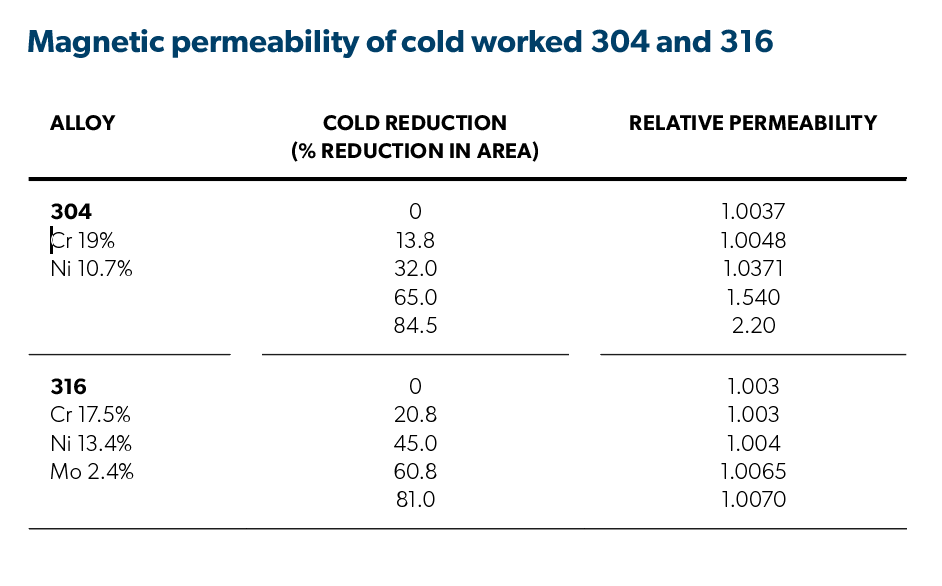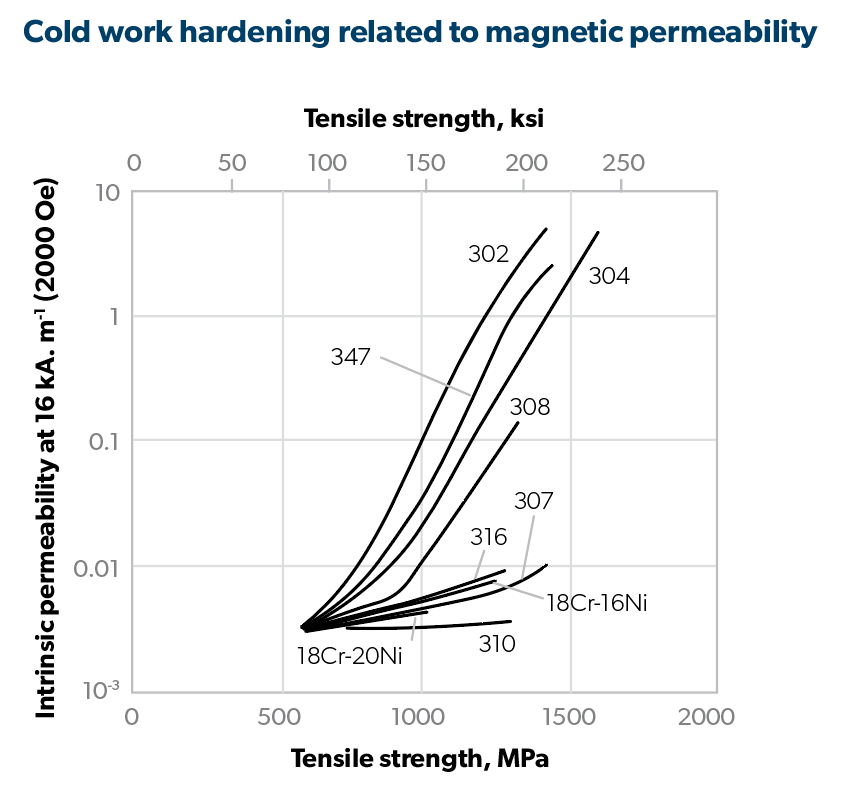The magnetic properties of materials are affected by their composition, metallic structure, processing methods and physical condition. Ferromagnetic materials are strongly attracted to a permanent magnet and may also be magnetised to act as a permanent magnet.
Download ASSDA Technical FAQ 3 (PDF)
Permeability is the property used to measure how well a material concentrates the magnetic field. It gives an indication of the strength of the attraction to a magnet.
It is more usual to refer to the relative permeability. This is measured relative to the value for air or vacuum taken as 1.
COLD WORK
Wrought, austenitic stainless steels, such as 304 and 316, are generally regarded as non-magnetic in the annealed condition, i.e. they are not attracted significantly by a magnet. However, if they are cold worked they will be attracted to a permanent magnet. The change occurs because the cold work deformation induces a transformation of the microstructure from austenite to martensite. The effect is less marked in alloys with high concentrations of austenite stabilisers such as nickel, nitrogen and carbon. Once the martensite is formed, it may also become magnetised sufficiently to pick-up light objects such as paper clips.
Magnetic attraction effects are most often noticed in heavily cold worked fabrications such as wire or the dished end of a pressure vessel. It is possible to remove the magnetic effects by solution annealing and water quenching but this will also reduce the tensile properties and may give rise to distortion.
MAGNETIC EFFECTS IN ANNEALED STAINLESS STEELS
In contrast to the austenitic alloys, ferritic stainless steels such as 409 or 3Cr12/5Cr12 and martensitic stainless steels such as 420, are strongly attracted to a magnet even in the annealed state. The duplex and super duplex stainless steels will also be strongly attracted because they contain about 50% ferrite in their microstructure.
The electrical demagnetising treatments applied when it is necessary to avoid permanent magnetic fields are fairly effective with magnetically soft materials such as ferrite. However, the strain-induced martensite in an austenitic stainless steel and the normal martensitic structure of (say) a 420, are reasonably magnetically hard and, once they are magnetised, it is difficult to electrically remove the permanent magnetic effect.
HEAT TREATMENT, WELDING AND MAGNETIC ATTRACTION
Poor heat treatment or high heat input welding of normal or high carbon austenitic stainless steels will cause sensitisation, ie formation of chromium carbides. The formation of carbides not only reduces the corrosion resistance of the stainless steel but also tends to form martensite around the carbide. This martensite is magnetic and the more severe the sensitisation, the stronger are the magnetic properties. This effect should not be confused with the intentional formation of a few percent of magnetic ferrite in notionally austenitic welds. This low ferrite concentration is required to give hot strength, i.e. to stop hot cracking during welding. The magnetic effects of weld ferrite are usually insignificant because welds are only a small part of a structure.
CASTINGS
Castings have subtly different compositions than the "equivalent" wrought alloys. The austenitic alloys typically have a few percent ferrite and are weakly attracted to a magnet, ie they are ferromagnetic. Ferritic, martensitic and duplex casting alloys have similar magnetic properties to their wrought counterparts.
EFFECT OF COLD WORK ON AUSTENITIC STAINLESS STEELS
The table below shows the relative permeability of 304 and 316 at a low magnetic field strength and various cold reductions. Highly alloyed austenitics including the high nitrogen grades do not develop low carbon martensite on cold work and so their relative permeability typically remains below 1.02. The values may be compared with mild or carbon steel which has a ferritic structure and a relative permeability of at least 200. Transformer steel has a relative permeability of at least several thousand.
The effect of composition and degree of cold work (measured by the tensile strength) on the permeability, and hence the strength of any magnetic attraction, is plotted below right for a series of austenitic alloys. It shows that increasing the nickel content reduces the effect of cold work on magnetic properties. Measurements were made on hot rolled sheet 2.4 to 3.2 mm thick which was cold rolled to specific strength.

